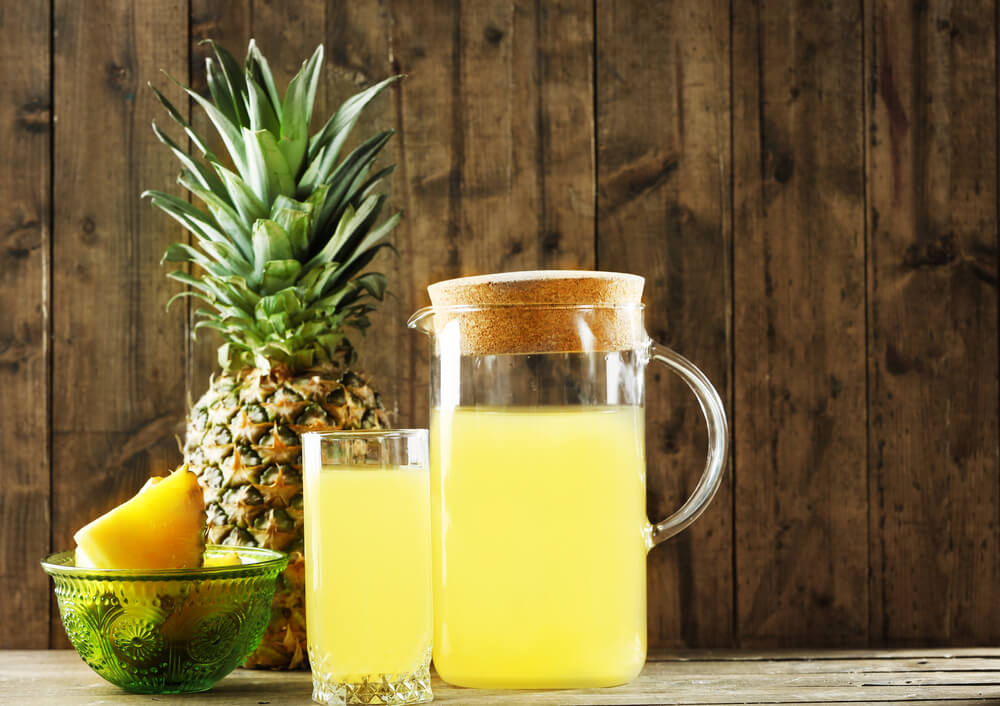5 Benefits Of Pineapple Juice: Ingredients, Methods
Pineapple Juice, the best nutrient-rich juice among all fruit juices, provides lots of health benefits because of its high quantity of minerals, fibers, enzymes, vitamin C, and energy.
The process used in this juicing recipe helps retain all dietary fibers and nutrients which otherwise are not available in its canned counterpart.
Apart from its health benefits, this recipe also uses black pepper and salt that adds nice salty-spicy zing to its sweet taste.
Ingredients:
1/2 Ripe Pineapple (regular size) (or 1½ cups chopped Fresh Pineapple)
A pinch of Ground Black Pepper (optional)
1-2 teaspoon Sugar or to taste (optional)
Pinch of Salt (optional)
1/2 cup Water
5-6 Ice cubes
Ingredients:
1/2 Ripe Pineapple (regular size) (or 1½ cups chopped Fresh Pineapple)
A pinch of Ground Black Pepper (optional)
1-2 teaspoon Sugar or to taste (optional)
Pinch of Salt (optional)
1/2 cup Water
5-6 Ice cubes
Method:

Step 1:
Select The Right Pineapple:
If your pineapple is under-ripe it will be sour. If it is overripe, it may be way too sweet.
Picking the right pineapple is the most important step in making tasty pineapple juice.
Smell the pineapple. A sweet scent is generally considered the most important aspect of choosing a ripe pineapple.
If it has no scent, it’s not ripe.
Avoid pineapples that smell fermented.
Although you want the pineapple to smell sweet, you do not want it to be so ripe that the sweet smell has an alcoholic or vinegar-like taint to it.
Look at the pineapple’s color. It will often reflect a golden-yellow color, but a green pineapple is not necessarily unripe.
Be aware that some pineapples are considered ripe when green.
Place more emphasis on the pineapple’s healthy appearance.
Avoid pineapples with wrinkled skin, reddish-brown skin, cracks or leaks, mold, or brown withering leaves.
You want the pineapple to be firm, but soft enough that it gives very slightly when you press down on it.
While you can use frozen or canned pineapple, fresh pineapples usually produce a better-tasting juice.
Step 2:
Cut Off The Stem:
Set the pineapple on your cutting board.
You will need a very sharp chef’s knife to peel a pineapple well.
Lay it on its side. Place your knife one-fourth inch (0.6cm) below the leaves.
Slice until you reach the leaves.
Turn the pineapple and repeat until you have cut the top of the pineapple and many of the leaves away in a circle.
Lift them through the center leaves and discard them.
You can use the remaining center leaves to hold the pineapple steady as you cut it.
Some cooks suggest cutting the entire top off.
You can do this also, but you should be careful not to let your hand slip from the top of the pineapple.
Cutting the pineapple releases a lot of slippery juice.
Step 3:
Peel The Pineapple:
Start at the top of the pineapple and slice through the outside peel until you reach the bottom.
You can cut in a slight outward-facing arc to save more pineapple fruit.
Turn the pineapple clockwise about two to four inches (five to 10cm) and repeat. Turn, slice, and repeat until you have removed the peel and only the eyes remain.
Place the pineapple on its side and cut the bottom off horizontally.
Discard the skin of the pineapple in your compost or the garbage can.
Step 4:
Remove The Eyes:
Hold the pineapple vertically and notice how the eyes are arranged in diagonal lines.
Removing just the eyes will reserve the largest amount of fruit.
Step 5:
Place Your Knife To The Left Of One Diagonal Line Of Eyes:
Cut in at a 45-degree angle just underneath the eyes.
Step 6:
Pick Up Your Knife And Place It To The Right Of The Same Diagonal Line:
Cut in at a 45-degree angle in the opposite direction.
When you slice this groove into the pineapple, the line of eyes will come free, keeping most of the sweet flesh on the rind.
Step 7:
Work Your Way Down:
Continue cutting from the top diagonal line to the bottom diagonal line, creating long parallel grooves in the pineapple’s flesh.
It will start to look like a spiral.
Step 8:
Turn The Pineapple A Quarter Turn A Repeat:
When you have worked your way around the pineapple, you will have a beautiful spiral pattern and bright yellow flesh.
Step 9:
Cut The Pineapple Into Fourths Vertically:
Cut the center core of the pineapple away in a vertical slice. Discard the core.
This part of the pineapple is tough and fibrous. It is also not very sweet.
Step 10:
Chunk The Pineapple:
Cutting your pineapple slices into chunks will help with blending them into juice later.
It doesn’t matter what size chunks you cut, but aim for about 1-inch chunks or smaller.
Step 11:
Blend Your Pineapple:
At this point, you want to blend until smooth.
The blending time may vary depending on your blender and the amount of water and ice you’ve added.
Try blending for a minute and then stop the blender and stir your mixture with a spoon.
After stirring, put the lid back on the blender and blend in 1-minute increments until smooth.
Step 12:
Strain Your Juice (optional):
If you tend to prefer juices without pulp, you may like to strain your pineapple juice before you drink it.
Otherwise, it is perfectly fine to drink just the way it is.
Step 13:
Serve:
Pour your pineapple juice into a tall chilled glass and garnish with pineapple wedges.
Pour your juice over ice and add a straw if you prefer.
Benefits Of Pineapple:
Highly Nutritious: with several vitamins/minerals, including vitamin C (100%), manganese (55%), Copper (19%), vitamin B6 (15%), etc., in just one 250ml cup.
Immune system booster: thanks to vitamin C (an antioxidant).
Anti-inflammatory: thanks to the bromelain enzyme in the pineapple, which also improves immunity and digestion!
Anti-cancerous: once again, thanks to the bromelain and antioxidants, which help to eliminate harmful free radicals (and cancerous cells) and oxidative stress.
Digestive aid: bromelain is at it again (along with the fiber when drinking the unstrained juice) to improve gut/bowel health.
Just be careful not to consume too much in one sitting, as it still contains high levels of fruit sugars, and the bromelain can also cause some mouth discomfort and tummy/digestive upset.
– Kehinde Owoeye






























































